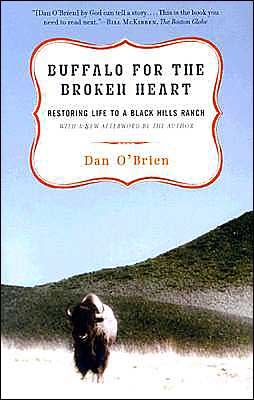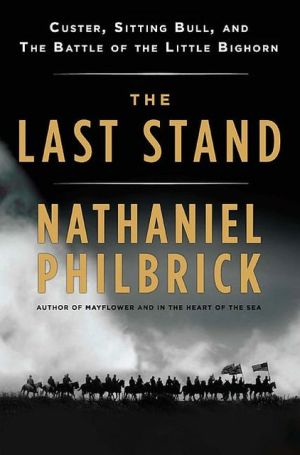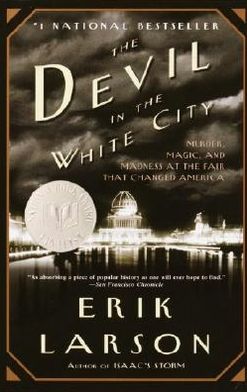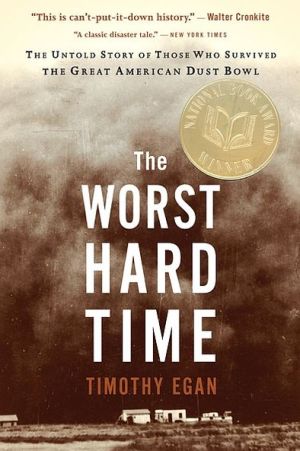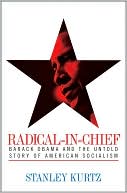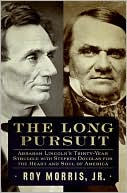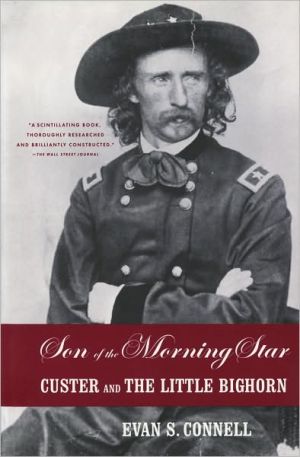Buffalo for the Broken Heart: Restoring Life to a Black Hills Ranch
For twenty years Dan O’Brien struggled to make ends meet on his cattle ranch in South Dakota. But when a neighbor invited him to lend a hand at the annual buffalo roundup, O’Brien was inspired to convert his own ranch, the Broken Heart, to buffalo. Starting with thirteen calves, “short-necked, golden balls of wool,” O’Brien embarked on a journey that returned buffalo to his land for the first time in more than a century and a half.\ Buffalo for the Broken Heart is at once a tender account of...
Search in google:
For twenty years Dan O’Brien struggled to make ends meet on his cattle ranch in South Dakota. But when a neighbor invited him to lend a hand at the annual buffalo roundup, O’Brien was inspired to convert his own ranch, the Broken Heart, to buffalo. Starting with thirteen calves, “short-necked, golden balls of wool,” O’Brien embarked on a journey that returned buffalo to his land for the first time in more than a century and a half.Buffalo for the Broken Heart is at once a tender account of the buffaloes’ first seasons on the ranch and an engaging lesson in wildlife ecology. Whether he’s describing the grazing pattern of the buffalo, the thrill of watching a falcon home in on its prey, or the comical spectacle of a buffalo bull wallowing in the mud, O’Brien combines a novelist’s eye for detail with a naturalist’s understanding to create an enriching, entertaining narrative. Publishers Weekly Veteran writer, rancher and environmentalist O'Brien (The Rites of Autumn) deftly chronicles his decision to restore buffalo to his 1,000-plus-acre South Dakota ranch for the first time in more than a century. Some 20 years before this life-changing decision, O'Brien was drawn by visions of "grass swaying in the wind to infinity and a sky that takes up half the world" to purchase the Broken Heart ranch. Despite his passion for the Great Plains and "the wild things that share the place," most of the intervening years were devoted to making a going concern of his cattle operation. Then, in January 1998, a recently divorced O'Brien sold his cows and purchased 13 buffalo "runts" from a neighbor. From this initial "crew of ragamuffins" he eventually built a herd of 100, assuming considerable financial risk to acquire the animals and construct eight miles of five-foot-high, barbed wire buffalo fence around his property. O'Brien reflects on how the symbiotic relationship between the animals and the prairie helped return his land to health. In contrast, he documents the difficulties of raising cattle, "sort of ungulate tourist[s]" ill-suited to the harsh plains landscape. Relying on his natural storytelling ability and a gift for character development, O'Brien interweaves his own experiences with a history of the region and engaging portraits of his neighbors. The result is a moving story of one man's love for a place and his desire to "make the land whole again." (Sept.) Copyright 2001 Cahners Business Information.
CHAPTER 1\ I’ve heard that when people in cities have a tough week at work—when it looks like they might lose their jobs or they’ve made some decision that threatens to ruin their lives—they sometimes wander the city. I’ve heard they sit in movie theaters all afternoon, watching the same movie over and over. They walk the open parks or stand on the wharves, staring at ships moving out to sea. The closest movie theater to me is forty miles away, and the ocean is another eighteen hundred miles east. But I’m surrounded by a million acres of open country, and when my world seems to be coming apart, I climb into my pickup and drive.\ Trying to make a life as a cattle rancher in the economy of the Great Plains makes for a lot of driving, and one late afternoon a dozen Septembers ago it led me to a remote dirt road along the southern boundary of Badlands National Monument. I was thinking about the mortgage payment that would be coming due in October, and the recent, inexplicable dip in cattle prices that would cut my income in half. I drove too fast, and when I came over a dusty rise I nearly ran into an enormous bull buffalo.\ He reclined luxuriously in the center of the dirt road, stretched out in the sun like a two-thousand-pound tomcat. With the exception of a whale I’d once caught a glimpse of, this was the biggest living thing I had ever seen. By the time I’d braked, I’d gotten way too close and was struggling to get the gear shift into reverse when he raised his head and looked straight into my eyes. I was close enough to see the grill of my pickup reflected in his round, dark eyes under a mop of dark, curly hair. His head was the size of a dishwasher.\ I managed to get the pickup into reverse but, like the wedding guest caught in the stare of the Ancient Mariner, I was frozen in place. We stared at each other for perhaps a minute, and for that minute all my business worries were dwarfed by this dose of reality lying in the road ahead. I focused on one of his eyelashes, long and expressive, as it batted away a yellow butterfly. Leisurely, the head dipped and the legs pulled under the great beast. The short, paintbrush tail whipped in the dust and the bull rocked once, twice, and up onto his feet. He shook like a dog, creating a cloud of dry South Dakota soil that drifted away on the cooling evening breeze. Then he slowly raised the tiny, black hoof of his left rear foot, stretched his head out, and, as if the hoof were a ballet slipper, scratched his neck below the long woolly goatee. He took one last look at me before he moved off the road, into a nearby draw and out of sight.\ Even then I sensed that that buffalo signalled something profound, but like the harried city-dweller drawn to ships moving on the ocean, I shook my head, unable to find the link between that dusty old bull and myself. I slipped the transmission into gear and immediately found myself back in the complexities of life. My anxiety had to do with trying to sustain myself in the unpredictable meteorological and economic climate of the northern plains that I am cursed to love.\ On the Great Plains the business of sustaining oneself usually ends up having something to do with agriculture, and agriculture usually means cattle grazing. The problem is that cattle grazing is not subject to generally accepted business practices. For example: once every year or so I used to get into a cattle deal together with my neighbor to the south. We’d buy some yearlings and try to put some weight on them for resale, or we’d get some old cows that were about ready to give birth and try to make a buck on the calves. Like everyone, we’d do our best to buy when the market was low and sell when it was high, and give the cattle good care that would turn our expenses into profit. But our plans almost never worked out and we resigned ourselves to the fact that capitalist enterprise on the Great Plains has its own set of rules. After a while, when we made a decision to try one of these schemes, my neighbor would sigh and say, “I sure hope we break even on this deal. I need the money.”\ In the mid-1980s the cost of fuel, interest rates, and cattle prices all soared. The economy was racing along a rosy highway until, for no apparent reason, cattle prices suddenly stalled, then fell. Everyone who owned a cow hit the windshield of that speeding economy, and the result was damage to the land, our dreams, and our self- esteem. The money we were certain we’d make on the cows—money that was to go to make the mortgage payments—vaporized. To paraphrase a popular joke: What’s the last thing that goes through a cowboy’s mind when he hits the windshield of a speeding economy? His ass.\ In some ways, I was luckier than most. Being in good health, and educated to make a living with books, I didn’t have to settle for a job in a gas station or a bar. The catch is that there are no jobs for people like me on the Great Plains, so I had to put the ranch in the care of a neighbor while I “worked out,” chasing jobs as an endangered-species biologist, or as an English teacher on the West Coast and in Colorado. I hated leaving the ranch, because by then, at thirty-nine, I had become addicted to watching the cycles of life on that certain little patch of prairie. But even if I had wanted to get away, I am a middle-class, middle-American kid, and I thought I had to find some way to make the land payments. It never occurred to me to tell the bank to stick the mortgage in their ear and, following in the footsteps of Dust Bowl refugees, go to California and “work out” for the rest of my life.\ Walking away from the mortgage would have been tough for me, but walking away from the land was impossible. Ever since a 1950s family trip to the West, crammed between two brothers in the backseat of a ’55 Chevy station wagon dragging a fold-up camper, I had dreamed of living on the edge of the Black Hills. When we wound our way down from the tourist town of Deadwood and found the prairie stretching north for a thousand miles into Canada, I turned to my mother and said, “There. Right there, where the land begins to flatten out and the trees disappear. That’s where I want to live.”\ It was a landscape so different from the tire factories, hardwood forests, and deep, black-soil farms of northwestern Ohio, where I was growing up, that my mother laughed. She reached over the back of the seat and patted my shoulder. “Don’t be silly,” she said, “it’s just a big, empty land”—a tiny condescension I have received from outsiders a thousand times since.\ My first vision of the northern Great Plains was a romantic little kid’s dream of cowboys, horses, and big sunsets. But it stuck with me. Now, no matter where I am, I can still close my eyes and see that sight from the north slope of the Black Hills: grass swaying in the wind to infinity and a sky that takes up half the world. It is the vision that has set the direction for my life.\ It’s taken me a long time to come to grips with the reality of life on the Great Plains, though it shouldn’t have. Twenty years after that first look, I took over one of the little ranches north of the Black Hills, and even before I signed the papers that gave me the right to start making payments on the place, I was aware that a previous owner had hung himself in the barn.\ I don’t know why this suicide happened, but I can imagine. I assumed a bad government-guaranteed Farmers Home Administration loan from the dead man’s son. He’d never made a payment but had repaired some fence and tried to remodel the house. The main building had been a grain bin for a generation and I’m sure he had a dream of making it the headquarters for a solid life on the land. He got as far into the dream as cheap window frames and rubber-backed carpet before his marriage blew up. He and his wife only lasted a couple years on the place before she filed for divorce and he developed a terrible thirst.\ I had very little money for a down payment and little experience as a rancher. But I had good credit and the government was in trouble on the loan. They were glad to get a new name on the note— another chance that the United States taxpayers wouldn’t end up writing the whole loan off. The Farmers Home Administration was foreclosing to satisfy a lien of $1,750 in back child-support payments. I found the horse barn half-filled with empty wine bottles. On the bank of each of the seven stock dams that water the place, I found Budweiser cans. On some dams they were scattered carelessly. On others they were piled, sometimes even stacked, like a monument created by someone deep in thought. I hauled three pickup loads of cans and bottles to the dump in the first week of my tenure as squire of the Broken Heart Ranch.\ The name is derived from my cattle brand, the unique arrangement of letters, numbers, or symbols that, according to state brand law, only I can burn into the hides of cattle. My brand is actually a lazy 3-V. Now, a lazy 3 is a 3 laid on its face, and if you place it just above a V, leaving a little bit of space between them, the brand becomes, unmistakably, a heart—rent in half. And that’s the brand that every cow that walks the place wears on its right shoulder. I never thought of the brand as a curse until 1998 when I went through my own divorce. My wife, Kris, and I had been married for ten years, and even though I had owned the ranch for years before we even met, she was never able to live there. Kris was a doctor with a high-pressure job at the regional hospital in Rapid City. We had a house in Rapid City and I drove back and forth. Some weekends she would come out, but it was always more like a visit. Eventually she moved to an even better job in Denver. She rightfully took the mutual fund and left me with the mortgaged ranch.\ The reasons for our breakup were complicated, but let it suffice to say that the fault was mostly mine. The pressure of owning up to my responsibility for that failed marriage did not, however, manifest itself in the same way as it did in my predecessors. I didn’t consider suicide or take to drinking alone on the banks of the stock dams. But I suffered a lot of guilt for my inability to give the marriage my best effort. Perhaps I was too involved with the land; too preoccupied with drought, high interest rates, low cattle prices; too concerned about the degraded pastures. All this settled on me in the form of stress. Stress, I found out from the doctors at the Mayo Clinic, can cause strange physical problems. In my case, I lost all my hair.\ It took months, but one morning I looked in the bathroom mirror and found what looked like a chemotherapy patient staring back at me. For a long time I retained eyebrows, and I tried to calm myself to save them. But every time I saw those cows walking around with broken hearts burned into their hides, I felt my eyebrows thinning.\ I came to hate cattle. They were not the reason I had come to this place, anyway. They were just the only way anyone out here had ever thought to try to pay the bills. Since I was a little boy I’d been attracted to wildness. It was for that reason I came to western South Dakota in the first place. It was the grouse, ducks, deer, antelope, hawks, rabbits, songbirds, shorebirds, fox, and coyotes that had lured me.
\ Publishers WeeklyVeteran writer, rancher and environmentalist O'Brien (The Rites of Autumn) deftly chronicles his decision to restore buffalo to his 1,000-plus-acre South Dakota ranch for the first time in more than a century. Some 20 years before this life-changing decision, O'Brien was drawn by visions of "grass swaying in the wind to infinity and a sky that takes up half the world" to purchase the Broken Heart ranch. Despite his passion for the Great Plains and "the wild things that share the place," most of the intervening years were devoted to making a going concern of his cattle operation. Then, in January 1998, a recently divorced O'Brien sold his cows and purchased 13 buffalo "runts" from a neighbor. From this initial "crew of ragamuffins" he eventually built a herd of 100, assuming considerable financial risk to acquire the animals and construct eight miles of five-foot-high, barbed wire buffalo fence around his property. O'Brien reflects on how the symbiotic relationship between the animals and the prairie helped return his land to health. In contrast, he documents the difficulties of raising cattle, "sort of ungulate tourist[s]" ill-suited to the harsh plains landscape. Relying on his natural storytelling ability and a gift for character development, O'Brien interweaves his own experiences with a history of the region and engaging portraits of his neighbors. The result is a moving story of one man's love for a place and his desire to "make the land whole again." (Sept.) Copyright 2001 Cahners Business Information.\ \ \ \ \ Library JournalAuthor of a number of fiction and nonfiction works dealing with falconry, ecology, and Western themes, including The Rites of Autumn and Brendan Prairie, O'Brien is also a cattle rancher recently turned buffalo rancher, which is the subject of his latest book. On one level, this is the story of the buffalo's fate on the Great Plains during the westward expansion following the Civil War. O'Brien writes knowledgeably of the early settlement of the region by farmers and ranchers, as well as the economics and ecology of modern-day ranching. On another level, this is the author's account of his small cattle ranch at the northern edge of South Dakota's Black Hills, the ups and downs of ranch life, and his ultimate decision to switch from cattle to buffalo and to restore the grasslands on his ranch. Plenty of real-life stories of O'Brien and his friends and neighbors are mixed in with broad themes of ranching, ecology, and the buffalo's place in the past, present, and future of the American West, which will make this book appealing to a wide audience. William H. Wiese, Iowa State Univ. Lib., Ames Copyright 2001 Cahners Business Information.\ \ \ Kirkus ReviewsA literate memoir from out where the buffalo roam. Novelist and nature writer O'Brien (The Contract Surgeon, 1999, etc.), who led a difficult enough life trying to raise cattle in the hills of southwestern South Dakota, found himself confronting still more troubles a few years back: his wife left him to pursue a medical career out of state, drought set in, and such little profit as was to be made in ranching disappeared with a rise in costs and drop in cattle prices. ("I sure hope we break even on this deal," one of his rancher friends remarks, apropos of one misguided business venture or another. "I need the money.") Already unusual among his neighbors in his concern for the ecological health of his place, O'Brien raised more than a few eyebrows locally when he decided to ease out of cattle ranching-which, he argues, is an alien economy in the context of the Great Plains, environmentally devastating and anachronistic-and introduce bison in the place of cows. "The difference between cattle and buffalo is obvious enough for anyone to see," he observes: Buffalo require little water, are less picky eaters than cows, and move around as they browse (so they don't graze a patch of grass down to the roots). O'Brien's account of the bison's return, mixed with entertaining sketches of his human neighbors and visitors, is bittersweet, especially in its closing pages. As a chronicle of ecological restoration, his report is premature: He's only been at the buffalo game for a couple of years, the market is still dicey, the land unhealed, the future uncertain. But as a chronicle of life in a lonely and difficult place, O'Brien's story is timeless-and entirely welcome.\ \
